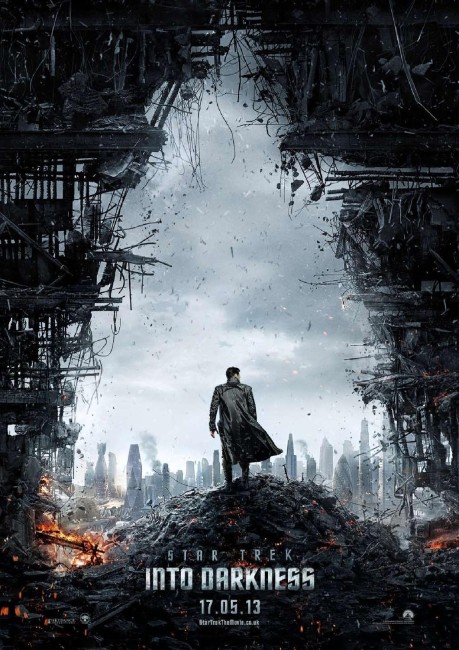USA. 2013.
Crew
Director – J.J. Abrams, Screenplay – Alex Kurtzman, Damon Lindelof & Roberto Orci, Producers – J.J. Abrams, Bryan Burk, Alex Kurtzman, Damon Lindelof & Roberto Orci, Photography (3D) – Dan Mindel, Music – Michael Giacchino, Visual Effects Supervisor – Roger Guyett, Visual Effects – Atomic Fiction (Supervisor – Kevin Baillie), Industrial Light and Magic, Kelvin Optical, Inc. & Pixomondo (Supervisor – Ben Grossman), Special Effects Supervisor – Burt Dalton, Creature Effects – AFX Studio, Production Design – Scott Chambliss. Production Company – Paramount/Skydance Productions/Bad Robot.
Cast
Chris Pine (Captain James T. Kirk), Zachary Quinto (Mr Spock), Benedict Cumberbatch (Khan Noonian Singh/John Harrison), Simon Pegg (Commander Montgomery Scott), Zoe Saldana (Lieutenant Nyota Uhura), Peter Weller (Admiral Alexander Marcus), Alice Eve (Carol Marcus), Karl Urban (Dr Leonard ‘Bones’ McCoy), John Cho (Lieutenant Hikaru Sulu), Anton Yelchin (Ensign Pavel Chekov), Bruce Greenwood (Captain Christopher Pike), Noel Clarke (Thomas Harewood), Leonard Nimoy (Spock Prime)
Plot
During a mission on the planet Nibiru, Captain Kirk violates the Prime Directive, exposing the existence of The Enterprise to the primitive natives, in order to rescue Spock as he is trapped in the midst of an exploding volcano. Back at Starfleet Headquarters, Kirk is stripped of the captaincy after Spock submits an honest report of the incident. Assigned as The Enterprise’s second-in-command under Christopher Pike, he is called to an emergency Starfleet session convened to deal with John Harrison, a rogue Starfleet officer responsible for detonating a bomb at a Federation archive in London. Kirk quickly deduces that this is a trap just as Harrison fires on the assembly from a small ship. Harrison makes an escape but Scotty detects that he transported to Kronos, an abandoned planet in the Klingon Empire. With Pike killed during the attack, Kirk requests the reinstatement of his captaincy from Admiral Marcus to go in pursuit. Marcus gives Kirk orders to arm The Enterprise with a series of photon torpedoes and fire these on Harrison from the safety of the Klingon Neutral Zone in order not to provoke a war with the Klingons. Others aboard the crew protest, even resign, at the idea of using the torpedoes. Arriving, Kirk makes the decision to instead head an armed force down to Kronos. They are attacked by Klingons, only to be saved by Harrison who then unexpectedly surrenders to them. On the journey back, Harrison reveals his real name is Khan Noonian Singh and that he is a genetically engineered superman created 300 years ago who was revived from suspended animation and recruited as a secret Starfleet weapons designer. He persuades Kirk that the Starfleet hierarchy have lied to him, revealing that the photon torpedoes in reality contain the 72 cryogenically frozen bodies of his comrades. As Starfleet comes hunting them, Kirk is forced to trust Khan as an ally.
Star Trek (1966-9) is a classic genre work. A short-lived tv series that was quickly killed off by its network, it grew into something else altogether – a major fan phenomenon that spawned three spinoff tv series, eleven films and countless merchandising in almost every available arena. (See below for the other Star Trek tv series and films). In the 00s, with the end of the last Trek tv series Enterprise (2001-5) and the poor returns of Star Trek: Nemesis (2002) in theatres, the Star Trek franchise seemed to be running to a creative end with Paramount uncertain of where to proceed from there.
Enter J.J. Abrams, a name who has rapidly become a major player in genre cinema and television during the latter half of the 00s. Abrams first emerged in the 1990s with scripts for films such as Regarding Henry (1991), Forever Young (1992) and Joy Ride (2001), before creating/producing the tv series Felicity (1998-2002). Abrams then became a cult name as creator and producer of the smart and stylish spy series Alias (2001-6) and, in particular, the huge hit of the mystery-laden desert island drama Lost (2004-10). Abrams has gone onto create a number of other genre tv series including the paranormal investigators series Fringe (2008-13), Person of Interest (2011-6) about a team that predict crimes before they happen, Alcatraz (2012) about temporally displaced prisoners, the post-apocalyptic Revolution (2012-4), Almost Human (2013-4) about a human cop and android partner, 11.22.63 (2016) about a time traveller attempting to prevent the assassination of President Kennedy, Westworld (2016-22), Castle Rock (2018-19), Lovecraft Country (2020) and Lisey’s Story (2021).
On the basis of Alias, Abrams was selected by Tom Cruise as the director of Mission: Impossible III (2006) and went onto a number of other successes on the big screen as director with Super 8 (2011), Star Wars Episode VII: The Force Awakens (2015) and Star Wars Episode IX: Rise of the Skywalker (2019), as well as producing Cloverfield (2008), Mission: Impossible – Ghost Protocol (2011), Mission: Impossible – Rogue Nation (2015), 10 Cloverfield Lane (2016), Star Wars Episode VIII: The Last Jedi (2017), The Cloverfield Paradox (2018), Mission: Impossible – Fallout (2018) and Overlord (2018).
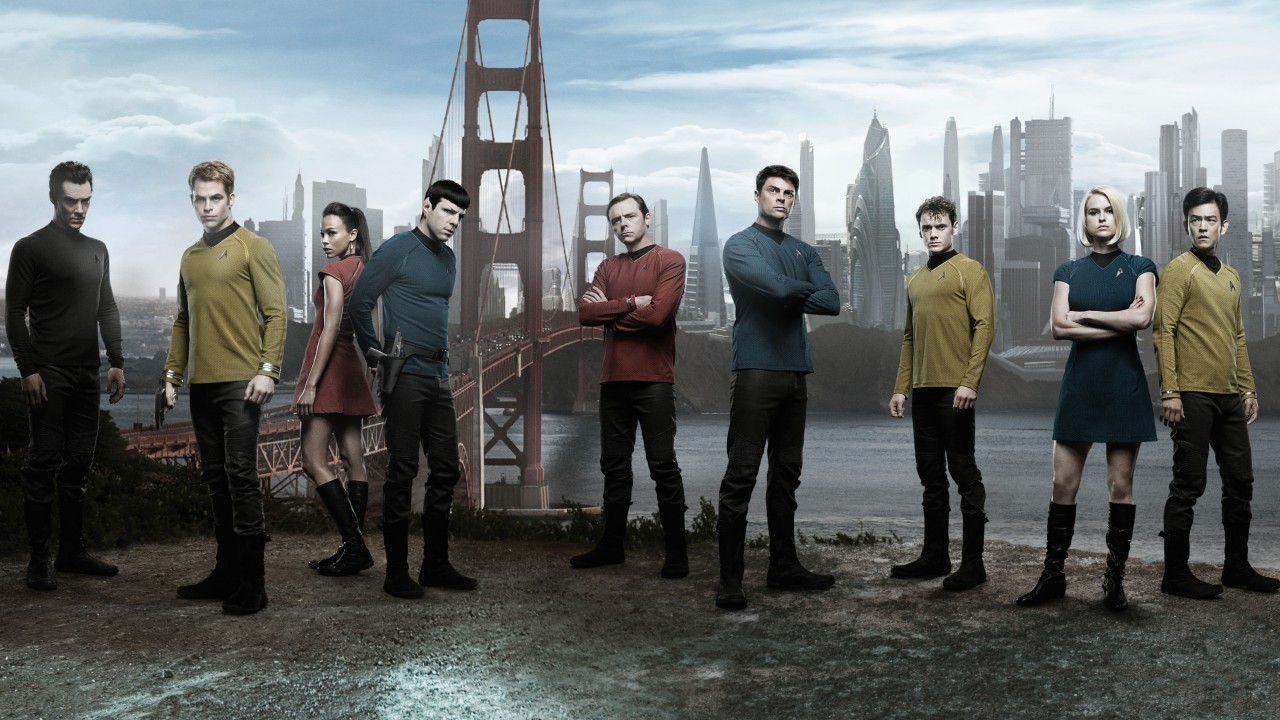
J.J. Abrams’ approach was to essentially reboot classic Star Trek not as a big screen version featuring the old actors but recasting the traditional roles with younger faces. The result was Star Trek (2009), which proved an international success. The classic characters were given a smarter, sexier overhaul with Abrams’ writers introducing an alternate timeline as a sleight of hand that allowed them to freely play around with franchise continuity. My own feelings were divided, as were those of many Star Trek traditionalists raised on the classic series. To paraphrase the tv series, “It was Star Trek, Jim, but not as we knew it.” J.J. Abrams and the same writing team return here with Star Trek: Into Darkness.
I was in two minds about the reconception of the characters in the first film. This time I decided to at least go with what J.J. Abrams and co were offering up – and surprisingly enough felt that everything worked better. Of the core ensemble, the players feel much more rehearsed and assured in their parts and even begin to approach far more the essence of the original characters in the tv series. Chris Pine seems much more grounded in the role of Captain Kirk, less like a young upstart and more at home in the command chair. Zachary Qunto is much better as Spock, perfectly nailing the humourless logical pedanticism that Leonard Nimoy mastered. (Although the Classic Trekker in one cringed at scenes where the film has this Spock crying or angrily trying to beat a downed Khan to a pulp, which feel like what fans refer to as ‘character rape’ where successive writers have a canonical character doing something that goes completely against their nature). A large part of the boost that Pine and Quinto get comes from the writing of their respective characters who are outfitted with a series of moral choices about death and sacrifice over duty, grief and emotion that play throughout the film. Quinto gets a particularly good soliloquy explaining his feeling to Zoe Saldana during a shuttle journey.
Into Darkness resurrects the character of the genetic superman Khan Noonian Singh played by Ricardo Montalban in the Space Seed (1967) episode of the original tv series and memorably resurrected in the second film outing Star Trek II: The Wrath of Khan (1982). The reason Khan was resurrected in Star Trek II, one suspects, is because the original series lacked anything like a super-villain to play off against – and the very act of doing so turned Khan into one of the most memorable villains in all of Trekdom. It is however best to try and forget about either of Ricardo Montalban’s outings before regarding the Khan we have here. The film borrows one or two aspects of continuity from the original – his being a genetic superman, the crew of cryogenically frozen survivors – but largely writes its own story. Benedict Cumberbatch, who has suddenly become a hot worldwide sensation after appearing as the title role in the BBC’s Sherlock (2010– ), certainly owns the part, playing with an ice coldness that is at exact opposite remove from Ricardo Montalban’s broadly theatrical playing. Star Trek: Into Darkness does interesting things with Khan – more on that below – but its failing is that it never turns the confrontation between he and Kirk into anything that approaches the epical showdown of wits while stealthily creeping around a nebula that we had in The Wrath of Khan.
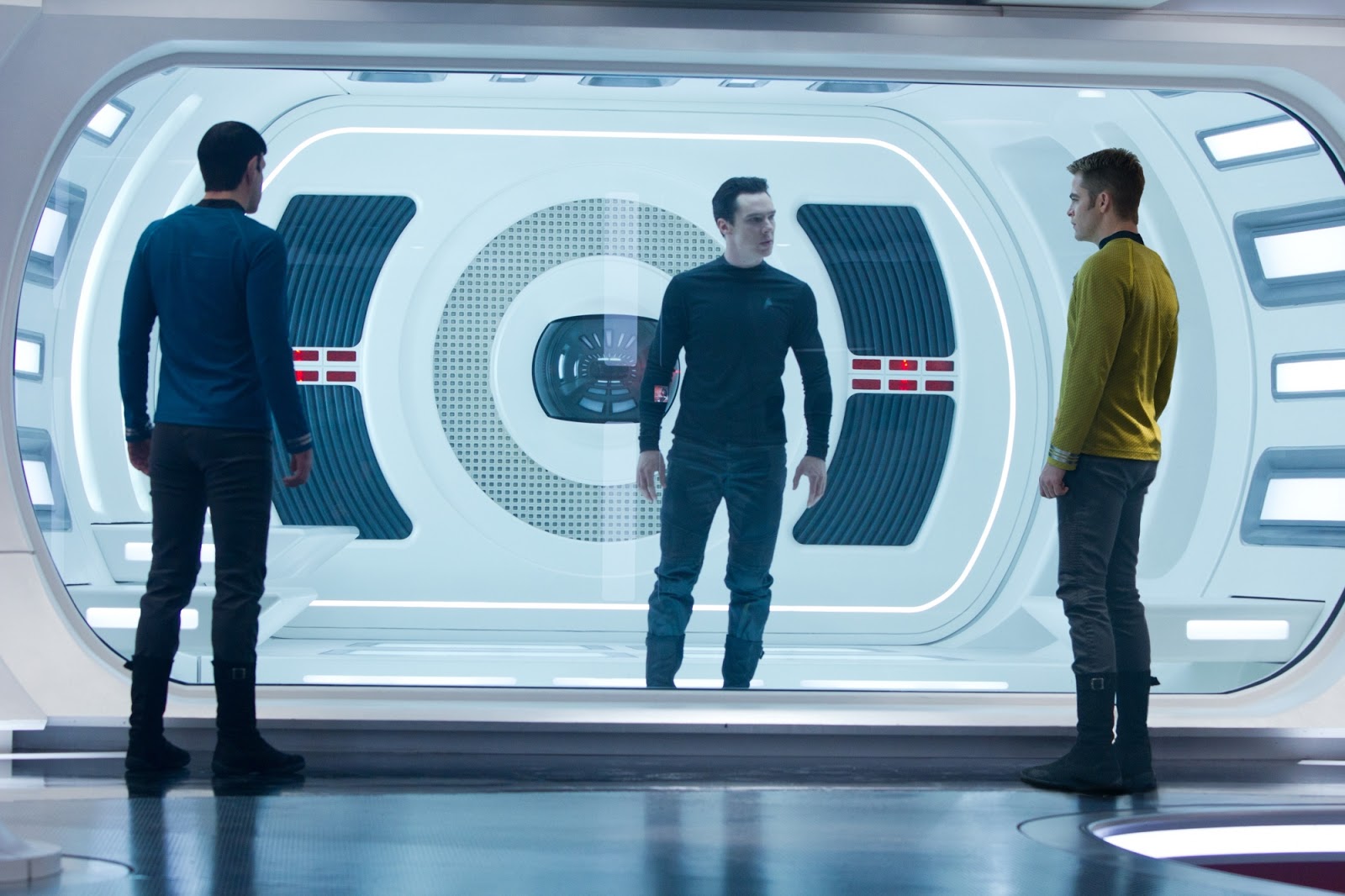
The original Star Trek had no qualms about making allegories for contemporary wars and social issues, although this ended up being dropped by the time of the films in favour of playing to fan nostalgia. Abrams and co return to that here where the character of Khan has been shoehorned onto a story about contemporary politics – corrupt military lying in the name of a greater perceived threat, their unleashing a dangerous weapon that turns against them, a villain who employs suicide bombers in his cause.
It is, if you like, Star Trek having been resurrected into the era of the George W. Bush-Obama White House – and quite critical of it too. We get scenes where several of the crew beg Kirk not to use photon torpedoes on a remote target – which reads as a coded attack on the amplification of remote-controlled drone assassinations under President Obama – and the interesting conflict that never seemed to concern any of the other Star Trek incarnations of an exploratory vessel being turned into a military one. In a radical move, Kirk joins in the terrorist striking back against the corruption in his own military.
As soon as Khan’s name is mentioned, you are expecting him to be the villain. To the contrary, Kurtzman, Orci and Lindelof proceed to turn this on its head and do some radical things with the character. As soon as Benedict Cumberbatch takes the stage proper, the film abruptly has Khan reveal that Kirk is being lied to and is an innocent dupe in the dealings of corrupt forces within Starfleet whereupon Kirk and Khan team up forces to take down those responsible. It goes from an epic battle between hero and supervillain as in The Wrath of Khan to an uneasy truce between sides against a greater enemy here. I liked the moral ambiguities at play throughout the script here – Kirk having to trust Khan at the same time as trying to hold him accountable for Pike’s murder – although after the exceedingly predictable twist where Khan turns out to be a villain after all, this becomes substantially less interesting.
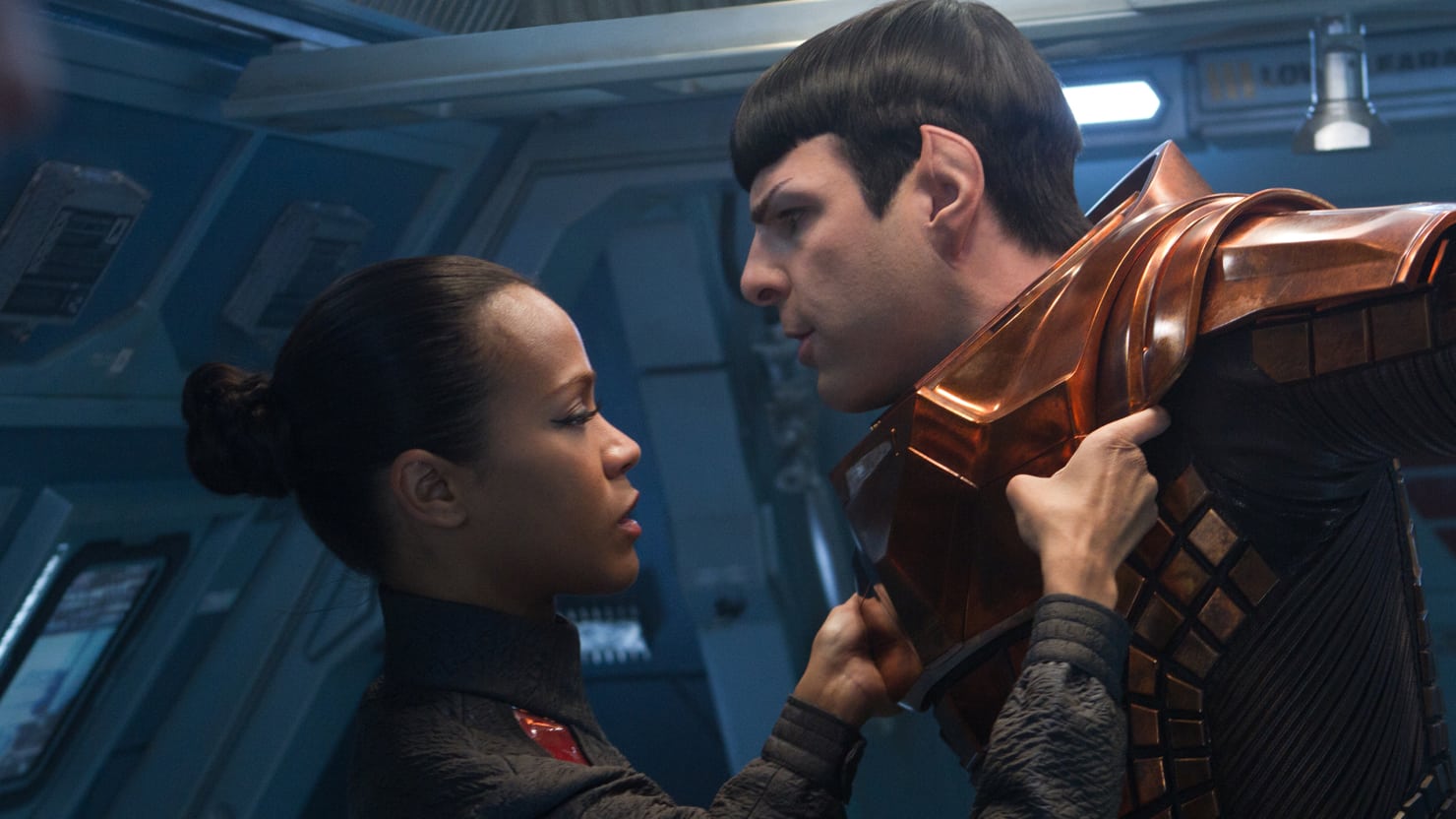
One thing that bugs me about Alex Kurtzman and Roberto Orci’s scripts is their cavalier-like attitude towards Star Trek canon. I get that they are rebooting the franchise and largely I am not that concerned about faithfulness to continuity. It is more how they constantly treat basic suspension of disbelief with a shrug of the shoulders. In the first film, Captain Kirk went from a fledgling ensign to a full ship’s captain in the space of a day. They invented Scotty’s transwarp teleportation allowing Kirk to transport light-years – here Benedict Cumberbatch casually uses it to teleport all the way from Earth to the Klingon Empire.
This is never more evident than during the opening scene where Kirk tosses aside the Prime Directive with a shrug of his shoulders, whips out a handily concealed scroll and pins it to a tree during their flight from the natives causing them to all fall in worship, they then dive off the cliff to find the submerged Enterprise before conducting a miraculous teleport rescue of Spock from the exploding volcano. The original and modern series involved technobabble solutions but there was the sense beneath all the talk of positronic circuitry, dilithium matrixes and inverse tachyon pulses where you could at least believe that the writers had invented a consistent science-fictional technical schema tying everything together; here you get the impression that Kurtzman, Orci and Lindelof are thinking why does it matter what happens when all of it is BS. The film almost feels like a constant series of improbable deus ex machina plot devices – Scotty turning up in Marcus’s ship at a convenient moment, the miracle cure of Khan’s blood, the scroll – produced out of the hat to save the day.
Perhaps the worst part of this is the climactic scene where [PLOT SPOILERS] Chris Pine’s Kirk enters the warpcore to reactivate it, in doing so giving his own life. This is a clear homage to the moving death of Spock at the end of The Wrath of Khan – but in being replayed here, it lacks any pathos. We, for one, can guess that the film is not going to kill off the franchise’s central character (The Wrath of Khan at least lacked that certainty, being given real world boosting by Leonard Nimoy’s constant vacillation over leaving the franchise). Moreover, the inherent tragedy of the scene is undercut by its coming in such obvious quotation marks where Orci, Kurtzman and Lindelof seem to think it is clever replaying the scene but with the twist reversal where it is Kirk being killed and it is Spock who roars “Khaaaaan!”. The subsequent realisation that Kirk can be revived by a sample of Khan’s blood is a plotting wave of the magic wand that becomes a comic-book death of the first order.
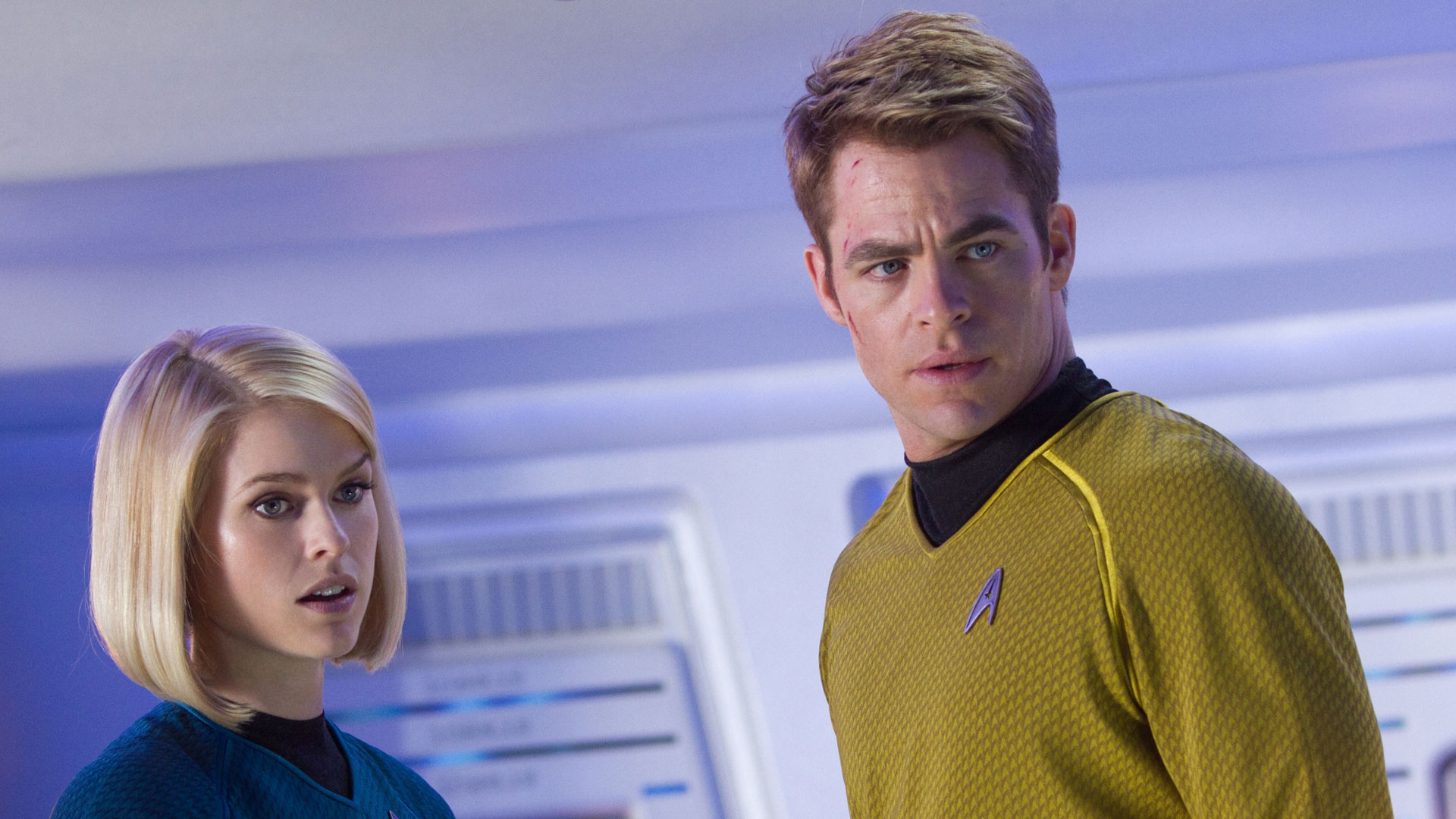
In the director’s chair, J.J. Abrams certainly creates a hurtling effects spectacle. It is a film that is constantly aiming for the breathtakingly spectacular – Chris Pine and Benedict Cumberbatch doing a spacesuited jump between two ships passing through a debris field at high speed; the climactic crash into the Earth’s atmosphere; the various ship battles. Some of these don’t work – we have seen too much of the type of scene with the shuttle flying sideways through a cliff in various Star Wars sequels and copies for it to be original, while the fight aboard cargo pods at the climax is strangely lacking in enervation. It is certainly the most action oriented Star Trek film we have had to date. The production designer does a fine job, creating a densely bustling Enterprise filled with acres of engine machinery (although one quibble is the way the film is constantly overdoing it on the lens flares to the point of distraction).
This was followed by Star Trek: Beyond (2016).
The original Star Trek tv series are:- Star Trek (1966-9) and the animated Star Trek (1973-5). The Classic Star Trek films are: Star Trek – The Motion Picture (1979), Star Trek II: The Wrath of Khan (1982), Star Trek III: The Search for Spock (1984), The Voyage Home: Star Trek IV (1986), Star Trek V: The Final Frontier (1989) and Star Trek VI: The Undiscovered Country (1991). The second generation Star Trek tv series are Star Trek: The Next Generation (1987-94), Star Trek: Deep Space Nine (1993-9), Star Trek: Voyager (1995-2001) and Enterprise (2001-5). Star Trek: Generations (1994), Star Trek: First Contact (1996), Star Trek: Insurrection (1998) and Star Trek: Nemesis (2002) are films based on Star Trek: The Next Generation. The third generation revival tv series are Star Trek: Discovery (2017-24), Star Trek: Picard (2020-23), the animated Star Trek: Lower Decks (2020- ), Star Trek: Prodigy (2021- ) and Star Trek: Strange New Worlds (2022- ). Star Trek: Section 31 (2025) was a film spinoff from the revival series.
Alex Kurtzman and his writing/producing partner Roberto Orci have been behind some of the biggest genre films of recent years. Kurtzman and Orci began work as writers/producers on tv’s Xena: Warrior Princess (1995-2001), Jack of All Trades (2000-1) and Alias (2001-6). Their first produced screenplay was Michael Bay’s The Island (2005) and they subsequently went on to write Mission: Impossible III (2006), Transformers (2007), Star Trek (2009), Transformers: Revenge of the Fallen (2009), Cowboys & Aliens (2011), Star Trek: Into Darkness (2013), The Amazing Spider-Man 2 (2014) and Star Trek: Beyond (2016), as well as to create and produce the tv series’ Fringe (2008-13), Hawaii Five-O (2010-20), Sleepy Hollow (2013-7), Matador (2014) and Scorpion (2014-8), and to produce the films Ender’s Game (2013) and Now You See Me (2013). Alex Kurtzman had previously made his directorial debut on the non-genre drama People Like Us (2002). On his own, Kurtzman went on to direct The Mummy (2017) and produce the tv series’ Salvation (2017-8), Star Trek: Discovery (2017-24), Star Trek: Picard (2020-23), Clarice (2021), Star Trek: Prodigy (2021- ), The Man Who Fell to Earth (2021-2) and Star Trek: Strange New Worlds (2022- ).
(Nominee for Best Supporting Actor (Benedict Cumberbatch), Best Special Effects and Best Production Design at this site’s Best of 2013 Awards).
Trailer here


